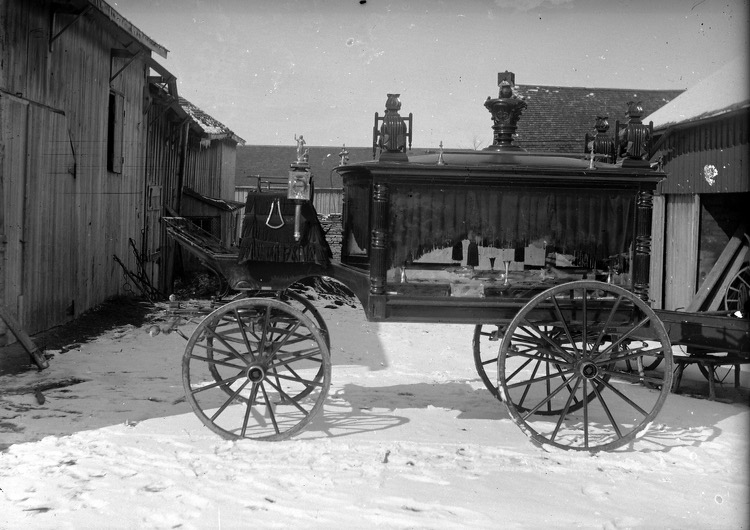Submitted by admin1 on

The Smallpox Epidemic of 1873-74 in Tavistock
By R. Paul Bartlett
The current Covid-19 pandemic was not the first serious outbreak to hit Tavistock and area. A search through the files of the Gazette at the Tavistock and District Historical Society reveals that there have been many diseases through the years that have been of concern to citizens of the community.
One disease that was in many ways similar to our current Covid-19 pandemic was the outbreak of smallpox that occurred in 1873-74. The details of this outbreak are found in the pages of the Woodstock Weekly Review, pages that were part of a donation of material of an historical nature given by Bill Gladding to the Historical Society earlier this year.
Smallpox first made its way into the Tavistock area in the early part of the summer of 1873. The first to contract the disease was a resident of Sebastopol who became infected while visiting some relatives near Harrington and he died shortly after returning home. Others caught it from him, principally his relatives, and one or two of them also died. The disease then appeared to abate but about the latter part of November it broke out afresh and would continue to be of concern for a number of months.
Smallpox was very prevalent in Tavistock in February of 1874, according to the Woodstock newspaper. At the first sign of the disease, the citizens had promptly organized a health committee and had adopted measures to prevent the spread of the disease. But “despite all the cautionary measures,” the paper reported, “it is still spreading and now a large proportion of the inhabitants are sick with it.” There had been forty or fifty cases in the village since the beginning of the outbreak and ten people had already died. At the time of the report, there were still eight or ten active cases, confined to three households.
Everything possible was done to prevent the spreading of the smallpox. The inspector for the Board of Health, Mr. John Poelman, laboured day and night in the performance of the “duties of his unenviable position.” Anyone in contact with any of the infected homes was quarantined for ten days “except under penalty of a heavy fine.” Travel to outside of Tavistock was also curtailed in order to prevent the spread to the neighbouring vicinity.
As today, there were some who believed that the reports of the malady were greatly exaggerated and did not take the danger seriously. “It is truly surprising”, the newspaper reported, “to see those from whom we might reasonably expect a display of better judgment heedlessly exposing themselves to its attacks, and there is little doubt unless more precaution is observed the malady will spread to other sections as yet free from its ravages. Let us hope in the name of all that is judicious and reasonable that more discretion will be observed in the future.”
And like today, there were some misconceptions about how the disease was spread. “A great outcry has been raised by the village people concerning the dogs, shaggy little fellows belonging to affected households, because they run in and out as they please, and playing with other dogs as hairy as themselves, spread the infection.” Smallpox like other viruses was spread by droplet from affected individuals to close contacts; there was no spread from animals.
As usual, the community was quick to jump in to help the families affected by the virus. “The villagers held a meeting for the purposes of raising funds to assist those who through having the disease in their families are now in needy circumstances; over $100 was raised on the spot and the list of donors has largely increased.” The financial records for the Township of East Zorra for the year 1874 list some of the expenses incurred during the epidemic. $110 was given to five families whose bedclothes were burned to prevent the spread of the smallpox. Janet Pringle was given $2.50 for making shrouds for a family whose members had died. Mary Zenda and Mary Reid were paid for services rendered as nurses to the sick. Dr Adams was paid $71 for being attendant on indigent smallpox patients. Others in the community were reimbursed for supplying groceries, beef and flour to the affected, and for cutting firewood. Kalbfleisch and Schaefer were paid for making coffins and W. Davis, Jacob Rhode and John Quehl were paid for digging graves.
By March of 1874, the smallpox epidemic was over. There was a sporadic case reported in 1879 and then there was another more serious outbreak in 1910. Fortunately by then vaccination was available and the spread of the disease was controlled. At a Cassel School reunion later on, one of the 1910 pupils remembered that they had written their exams that year with sore arms.
Smallpox is a disease of the past; it has been eradicated by a world-wide vaccination campaign. There are many other diseases that were prevalent in the past but not a problem today. Think of diphtheria, measles, puerperal sepsis, scarlet fever, rheumatic fever, anthrax, and salmonella. There were polio epidemics in 1937 and again in 1951—a 16 year old boy from East Zorra became sick on a Wednesday and died on a Friday that year. Thankfully, through vaccinations and the efforts of public health, most of these diseases do not cause fear and panic today like they did in the past.
In the Tavistock Gazette of January 27 1916 was the note, “The Board of Health is now providing free of charge smallpox vaccine, diphtheria antitoxin, tetanus antitoxin, anti-meningitis serum, anti-typhoid vaccine and preventative treatment for rabies, all to try to keep death rate down.”
And then in 1918-1919, the Spanish influenza hit the area. But that’s another story.